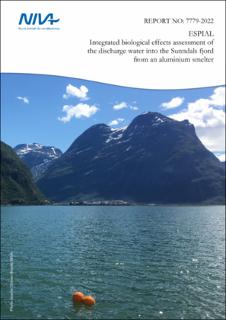| dc.contributor.author | Brooks, Steven | |
| dc.contributor.author | Gomes, Tania | |
| dc.contributor.author | Grung, Merete | |
| dc.contributor.author | Macken, Ailbhe | |
| dc.date.accessioned | 2023-02-15T09:53:19Z | |
| dc.date.available | 2023-02-15T09:53:19Z | |
| dc.date.created | 2023-02-14T14:44:45Z | |
| dc.date.issued | 2022 | |
| dc.identifier.isbn | 978-82-577-7515-5 | |
| dc.identifier.issn | 1894-7948 | |
| dc.identifier.uri | https://hdl.handle.net/11250/3050991 | |
| dc.description | Prosjektleder: Ailbhe Macken | en_US |
| dc.description | Andre reviderte versjon av rapport 7537-2020. Første revisjon: 7543-2020. | |
| dc.description.abstract | The following study describes an integrated biological effects monitoring programme using field transplanted mussels to determine the potential biological effects of the effluent discharge from Hydro’s aluminium smelter in the Sunndals fjord. Chemical body burden (PAH and metals) and a suite of biological effects markers were measured in mussels positioned at known distances (1, 2, 5, 10 and 20 km) from the aluminium smelter for 6 weeks. Overall, the biological responses observed where greater in the mussels positioned closest to the smelters discharge (1 – 5 km), although the chemical concentrations in mussel tissues were low and below the expected threshold levels. The lowest chemical accumulation and biomarker responses were observed in mussels positioned 10 km from the smelter. Mussels located furthest from the smelter exhibited significant biomarker responses, probably associated with a different contaminant source. The integrated biological response index (IBR) reflected the expected level of exposure to the smelters discharge and the Principal component analysis (PCA) differentiated between the mussel groups, with the most impacted located closest to the smelters discharge. Not one chemical factor explained the biological responses in mussels, correlations were found between certain measured contaminants (i.e. PAH, Mn, Ni and Cr) and distance from the smelter, although the concentrations of these contaminants were low and unlikely to have caused the biological effects observed in the mussels (1 and 5 km). | en_US |
| dc.description.sponsorship | Aluminiumindustriens Miljøsekretariat (AMS) | en_US |
| dc.language.iso | eng | en_US |
| dc.publisher | Norsk institutt for vannforskning | en_US |
| dc.relation.ispartof | NIVA-rapport | |
| dc.relation.ispartofseries | NIVA-rapport;7779-2022 | |
| dc.subject | Smelteverk av aluminium | en_US |
| dc.subject | Aluminium smelter | en_US |
| dc.subject | Norsk fjord | en_US |
| dc.subject | Norwegian fjord | en_US |
| dc.subject | Biomarkører | en_US |
| dc.subject | Biomarkers | en_US |
| dc.subject | Avløp | en_US |
| dc.subject | Effluent discharge | en_US |
| dc.title | Integrated biological effects assessment of the discharge water into the Sunndals fjord from an aluminium smelter | en_US |
| dc.title.alternative | Integrated biological effects assessment of the discharge water into the Sunndals fjord from an aluminium smelter | en_US |
| dc.type | Research report | en_US |
| dc.description.version | publishedVersion | en_US |
| dc.rights.holder | © Norsk institutt for vannforskning/Norwegian Institute for Water Research. The publication can be cited freely if the source is stated. | en_US |
| dc.subject.nsi | VDP::Matematikk og naturvitenskap: 400 | en_US |
| dc.subject.nsi | VDP::Mathematics and natural scienses: 400 | en_US |
| dc.source.pagenumber | 45 | en_US |
| dc.source.issue | 7779-2022 | en_US |
| dc.identifier.cristin | 2126033 | |
| dc.relation.project | 180282 | en_US |
| cristin.ispublished | true | |
| cristin.fulltext | original | |
